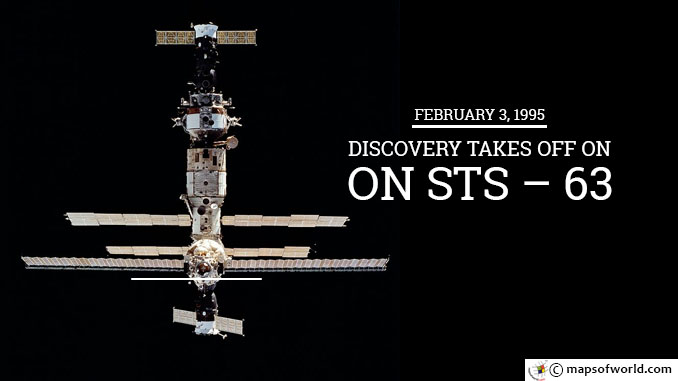On February 3, 1995, the space shuttle Discovery took off on STS – 63, the first space mission to be piloted by a woman Lt Col Eileen Collins. This was Collins’ first spaceflight. The mission, named STS – 63 part of NASA’s Space Shuttle program – the only implemented part of the Space Transportation System. STS – 63 was launched on February 3, 1995, at 05:22:04 UTC from the John F Kennedy Space Center launch site on Merritt Island, Florida. This was the 20th mission for space shuttle Discovery which spent about 8 days, 6 hours, 28 minutes, and 15 seconds in space and covered a distance of 2,992,806 miles. Discovery was to carry a crew of 6 members and was commanded by Captain James D Wetherbee. Apart from the pilot Collins, the shuttle carried 4 mission specialists – Bernard Harris Jr, Michael Foale, Janice Voss, and Vladimir Titov. The mission, also referred to as the ‘Near-Mir’ mission was a planned rendezvous and fly around of the Russia’s space station Mir, in preparation for a future mission to dock with Mir. The specially fitted cameras on Discovery were used to study the viability of restocking the space station. The mission successfully deployed and recalled SPARTAN-204 platform which was used to study celestial objects and the space. The crew of Discovery STS – 63 worked extensively with payloads and SPACEHAB-3. The module carried out 20 experiments aboard the Discovery on the mission which included a number of plant experiments and experiments with the immune system. On this mission Harris became the first African-American to walk in space with the 29th spacewalk lasting about 4 hours, 38 minutes. The mission ended successfully on February 11, 1995. The space shuttle used for the mission STS – 63, Discovery was NASA’s third operational orbiter; the other two were called Columbia and Challenger. Discovery’s maiden flight was on August 30, 1984, on mission STS – 41-D. By the time it was decommissioned, Discovery had flown about 39 missions and had spent a total of 365 days, 22 hours, 39 minutes, and 33 seconds in space. The space shuttle had ferried 252 astronauts and traveled 148,22,675 miles in all. Discovery flew a number of important missions including the International Space Station research and assembly missions and also flew the Hubble Space Telescope into orbit. After 27 years of service, Discovery became the first operational shuttle of NASA to be retired. Discovery was NASA’s chosen vehicle for both its “return-to-flight” missions. On April 17, 2012, Discovery was sent from Kennedy Space Center to Washington, D.C., where it was sent to be displayed at the Smithsonian Institution’s National Air and Space Museum. Born in November 1956, New Yorker Lt Col Eileen Marie Collins was the second woman to graduate as a test pilot with the US Air Force. Collins was chosen as an astronaut by NASA and went through many years of training before she became the first woman to pilot a space shuttle in 1995. Again in 1997, Collins piloted the space shuttle Atlantis on its mission STS-84, on its rendezvous with Mir to deliver over 7,000 pounds of equipment. She was also chosen to be the first woman to command a space shuttle when she led Columbia in July 1999 to deploy Chandra X-ray Observatory on the mission STS – 93. In the year 2005, she also commanded STS – 114, NASA’s “Return to Flight” space mission following the space shuttle Columbia disaster. In 2006, Collins finally left NASA and found a place in the US Astronaut Hall of Fame in 2013. You may also like : February 3 1451 – Mehmed II Becomes Sultan of the Ottoman Empire
February 3 1995 – Discovery takes off on STS – 63
On February 3, 1995, the space shuttle Discovery took off on STS – 63, the first space mission to be piloted by a woman Lt Col Eileen Collins. This was…
361
